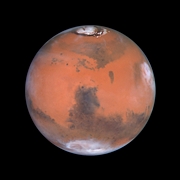
March 3, 2004 Pasadena, California - At the March 2, 2004, NASA press conference in Washington, D. C., I learned from German geologist, Goestar Klingelhoefer, Ph.D., that his Mossbauer spectrometer needs an area of about 1.5 centimeters in order to get accurate readings about iron and other elements. Very small objects such as the many unidentified spherules, or "blueberries," at the Opportunity Meridiani Planum site are too small for the Mossbauer to get an accurate reading on one, or even a few. The spherule diameters range from 1 to 5 millimeters. To date, what those mysterious little balls are made of is still a mystery.So, in the next couple of weeks, it is hoped that the Opportunity rover can put its robotic arm and various sensors - including the Mossbauer - down against a concentration of the spherules. The idea is that the instruments would then have a dense, larger area in which to take measurements.
Click here to subscribe and get instant access to read this report.
Click here to check your existing subscription status.
Existing members, login below:
© 1998 - 2024 by Linda Moulton Howe.
All Rights Reserved.

